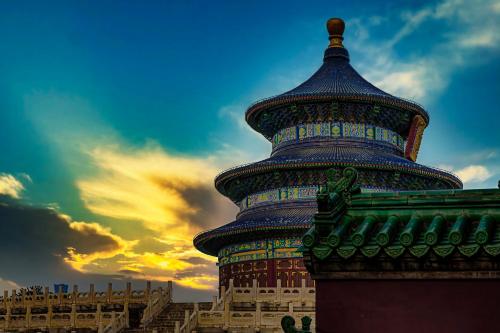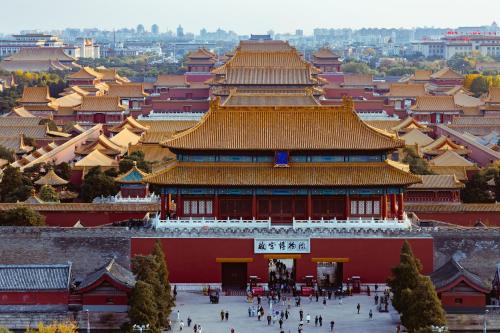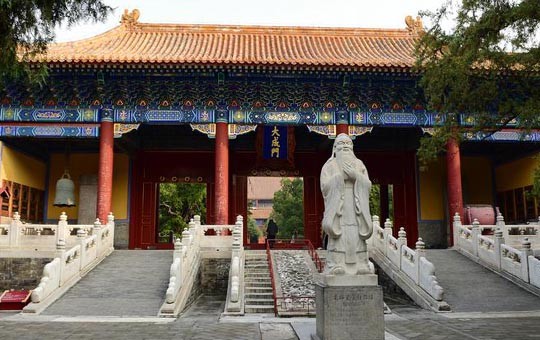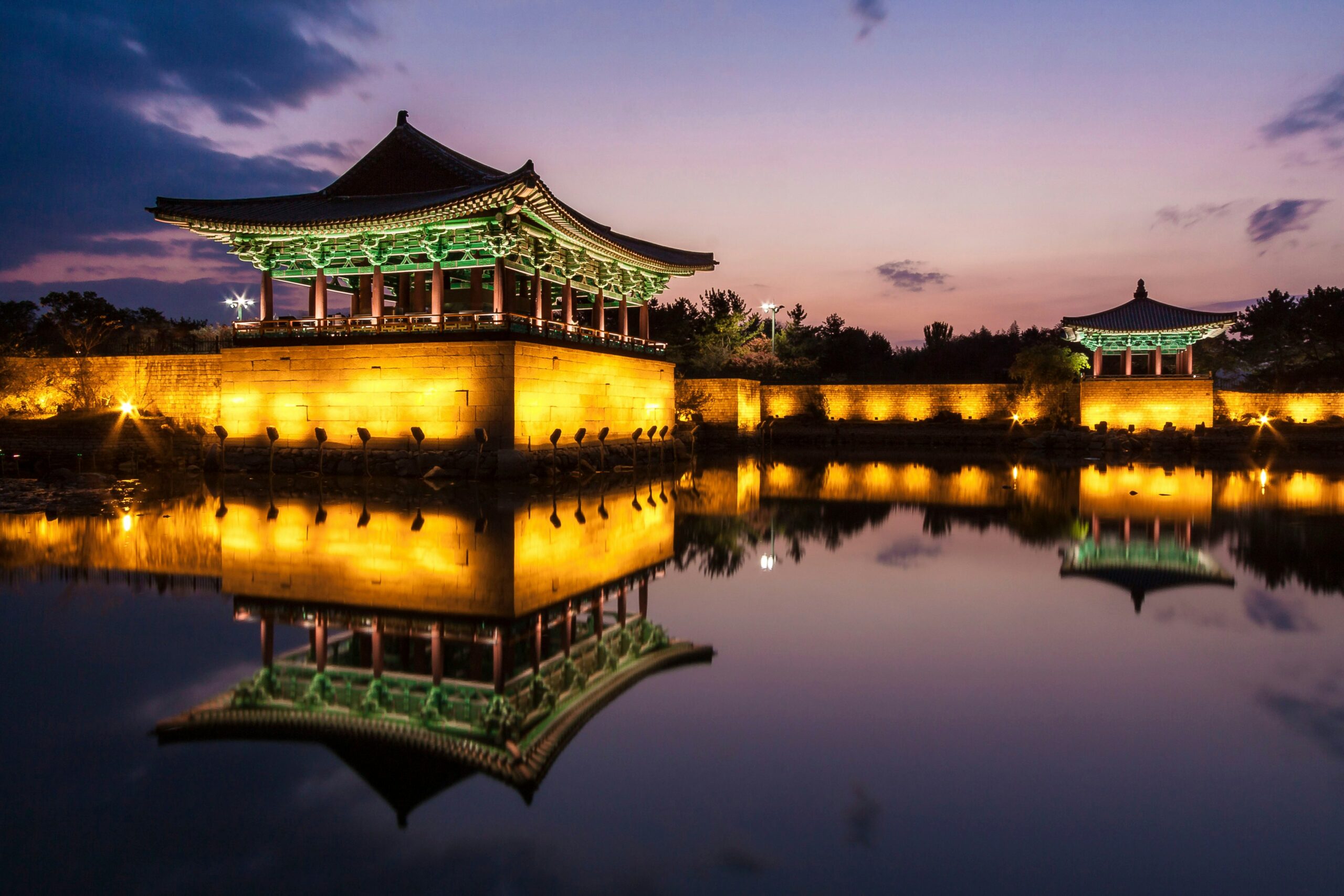Cultural Insights: The Significance of Beijing’s Confucius Temple and Imperial College

An Essential Guide to Visiting Beijing_Confucius_Temple_And_Imperial_College
Nestled in the heart of Beijing, the Temple of Confucius and the Imperial College stand as enduring symbols of China’s rich intellectual heritage and reverence for learning. Established during the Yuan Dynasty, this remarkable site invites visitors to delve into the philosophical teachings of Confucius, a figure whose ideals have shaped Chinese culture for centuries. As the second largest Confucian temple in the country, it boasts a serene atmosphere that contrasts with the bustling city beyond its walls.
Walking through the temple’s ornate courtyards, you’ll encounter splendid architecture adorned with intricate carvings and vibrant colors, each element telling a story of the past. The adjacent Imperial College, once the epicenter of scholarly pursuits during the Yuan, Ming, and Qing dynasties, further enriches your experience, showcasing the rigorous examination system that determined the fate of countless scholars.
Whether you’re a history buff, a lover of architecture, or simply seeking a peaceful retreat, this duo of cultural landmarks offers a unique glimpse into the ideals that have guided Chinese society. Join us as we explore the profound legacy of the Temple of Confucius and the Imperial College, where tradition meets tranquility in a captivating journey through time.
In This Guide
- An Essential Guide to Visiting Beijing_Confucius_Temple_And_Imperial_College
- The Rich History and Legends of Beijing_Confucius_Temple_And_Imperial_College
- Main Highlights: What You Absolutely Can’t Miss
- Planning Your Visit: A Practical Guide
- Tickets: Prices, Booking, and Tips
- How to Get There: A Complete Transportation Guide
- Local Cuisine and Accommodation Nearby
- Frequently Asked Questions
- Final Thoughts on Your Trip
The Rich History and Legends of Beijing_Confucius_Temple_And_Imperial_College
Nestled in the heart of Beijing, the Confucius Temple and the Imperial College serve as eloquent reminders of China’s rich intellectual heritage. Established during the Yuan Dynasty, the temple complex is steeped in history, dating back to its founding in 1302, when it was created to honor the revered philosopher Confucius, known as the Great Sage. This significant site has witnessed the evolution of education and governance in China across the Yuan, Ming, and Qing dynasties.
The Temple of Confucius is the second largest of its kind in China, surpassed only by the one in Qufu, Confucius’ birthplace. The original purpose of the temple was not only to pay homage to Confucius but also to provide a sacred space for scholars to gather and offer sacrifices. Over the centuries, it has undergone numerous renovations, resulting in the grand architectural features we admire today. The temple’s impressive layout follows a traditional design, with structures meticulously arranged along a central axis, reflecting the importance of harmony and order in Confucian philosophy.
Adjacent to the temple lies the Guozijian, or Imperial College, which was founded in 1306. This institution was the pinnacle of education in imperial China, responsible for training scholars who would go on to hold prestigious government positions. The college operated under a rigorous examination system that was pivotal for social mobility and the selection of talented officials. The stone tablets lining the halls of the temple bear the names of those who succeeded in the demanding imperial examinations, a testament to their intellect and dedication.
At the heart of the temple complex is the majestic Dacheng Hall, where visitors can witness a statue of Confucius surrounded by stone plaques and steles, some inscribed by emperors themselves. This hall continues to host sacrificial ceremonies that honor Confucius, further solidifying the temple’s role as a living museum of Confucian thought.
Throughout its history, the Confucius Temple and Imperial College have played an essential role in the cultural transmission of Confucian ideals. The site is home to numerous inscriptions of Confucian classics, including “The Analects” and “The Great Learning,” which serve not only as historical artifacts but also as vital carriers of wisdom and philosophical teachings that have shaped Chinese civilization.
Visitors to the temple can immerse themselves in both its serene atmosphere and its profound legacy. The annual ceremonies held in honor of Confucius, particularly on his birthday, attract crowds that reflect the enduring respect and reverence for his teachings. The temple and college together offer a unique opportunity to explore the intertwining tales of education, philosophy, and governance that have defined China’s storied past.
In essence, a visit to the Confucius Temple and the Imperial College is not just a journey through ancient architecture but a deep dive into the intellectual and cultural currents that continue to influence China today. This sacred space invites travelers to reflect on the teachings of Confucius and the ideals that have guided generations, making it a must-see for anyone seeking to understand the rich tapestry of Chinese history.

Beijing_Confucius_Temple_And_Imperial_College.
Main Highlights: What You Absolutely Can’t Miss
When visiting the Beijing Temple of Confucius and the adjacent Imperial College, there are several key highlights that you absolutely cannot miss. These sites not only showcase stunning architecture but also offer deep insights into Chinese history and culture.
The Temple of Confucius
-
Dacheng Hall
The centerpiece of the temple, Dacheng Hall, is a magnificent structure adorned with a striking yellow-glazed roof, symbolizing Confucius’ revered status. Inside, you’ll find an impressive statue of Confucius surrounded by stone plaques and inscriptions from emperors like Kangxi and Qianlong. This hall is not just architecturally impressive; it is a site of ongoing ceremonial significance, where sacrificial rites are performed during key festivals. -
Jinshi Stone Tablets
A unique feature of the temple is the collection of Jinshi Stone Tablets, which commemorate the names of over 50,000 scholars who passed the esteemed Jinshi examinations from the Yuan to the Qing dynasties. Walking amidst these steles offers a glimpse into the scholarly achievements of historical figures and is a poignant reminder of the rigorous academic traditions that shaped ancient Chinese society. -
Chong-Sheng Memorial Hall
Make sure to catch the free performance of Confucian ritual music, known as dacheng, held hourly in this hall. This 15-minute performance is a captivating way to immerse yourself in the musical traditions of Confucianism while appreciating the hall’s serene atmosphere.
The Imperial College (Guozijian Museum)
-
Exhibition of Imperial Examination Culture
Once the heart of China’s imperial education system, the Guozijian Museum now serves as a repository of knowledge regarding the imperial examination process. Here, visitors can explore displays that illustrate the rigorous selection of government officials throughout the centuries, providing valuable insights into the socio-political fabric of historical China. -
Qianlong Stone Classics Exhibition Hall
This exhibition hall showcases intricately carved stone tablets containing key works of Confucian literature, including the “Four Books” and “Five Classics.” Commissioned during the reign of Emperor Qianlong, these stone classics represent not only artistic achievement but also the Qing Dynasty’s commitment to preserving cultural heritage.
Architectural Beauty
Both the Temple of Confucius and the Imperial College are celebrated for their traditional Chinese architectural styles. The symmetrical layout, intricate carvings, and use of vibrant colors create a visually stunning experience. The tranquil environment, often less crowded than other temples in Beijing, allows for a peaceful exploration of these historical sites.
Practical Information
- Opening Hours: Open from 8:30 AM to 5:00 PM (last entry at 4:30 PM). Note that the site is closed on Mondays.
- Entrance Fee: 30 CNY.
- Location: A short walk from the Lama Temple, easily accessible via subway lines 2 and 5.
Conclusion
Visiting the Beijing Temple of Confucius and the Imperial College offers not just a journey through beautiful architecture but also a deep dive into the educational and philosophical traditions that have shaped Chinese civilization for centuries. Whether you’re a history enthusiast, an architecture lover, or simply seeking a serene escape from the bustling city, these highlights will surely enrich your travel experience in Beijing.

Beijing_Confucius_Temple_And_Imperial_College.
Planning Your Visit: A Practical Guide
Planning Your Visit: A Practical Guide
When it comes to exploring the cultural heart of Beijing, the Temple of Confucius and the Imperial College Museum are not to be missed. This pair of historical sites offers a fascinating glimpse into China’s rich educational heritage and the enduring legacy of Confucian philosophy. Here’s everything you need to know to make the most of your visit.
Location and Getting There
The Temple of Confucius and the Imperial College Museum are conveniently located near the Lama Temple, making it easy to combine visits. To get there via public transport, take Subway Line 2 or Line 5 to the Lama Temple station. From there, it’s just a short walk to the entrance.
Address:
No. 13, Guozijian Street, Dongcheng District, Beijing
Opening Hours
- Temple of Confucius: Tuesday to Sunday, 9:00 AM – 5:00 PM (last entry at 4:30 PM); closed on Mondays, except during public holidays.
- Dacheng Ritual Music Performances: Hourly performances at 10:00 AM, 11:00 AM, 2:00 PM, 3:00 PM, and 4:00 PM.
Admission Fees
- General Admission: 30 RMB (approximately $4.50 USD)
- Student Admission: 15 RMB (for undergraduate and lower-level students)
Tickets can be purchased on-site or in advance through the official WeChat accounts.
Recommended Visiting Duration
Allocate about 2-3 hours for your visit. This allows ample time to explore the various halls, appreciate the intricate architecture, and enjoy the cultural performances.
Highlights to Explore
-
Dacheng Hall: The centerpiece of the temple, this grand hall features a statue of Confucius and is where many ceremonial events take place.
-
Jinshi Stone Tablets: A striking collection that honors scholars who passed the imperial examinations, providing a tangible connection to China’s educational history.
-
Qianlong Stone Classics Exhibition Hall: Here, visitors can admire stone carvings of Confucian classics, showcasing the artistry and dedication of Qing Dynasty scholars.
-
Chong-Sheng Memorial Hall: Don’t miss the chance to experience the free performances of traditional Confucian ritual music that take place here.
Best Time to Visit
The sites are beautiful year-round; however, visiting during the spring (March to May) and autumn (September to November) offers pleasant weather and vibrant scenery. Early mornings or late afternoons are ideal for a quieter experience.
Nearby Dining Options
After exploring the temple, treat yourself to local cuisine. A popular spot nearby is Xilou Wangji Beef Noodles, where you can savor delicious deep-fried vegetarian balls and the house special beef noodles.
Tips for a Successful Visit
- Dress Comfortably: Expect to do some walking, so wear comfortable shoes.
- Audio Guides: Consider renting an audio guide for 30 RMB in English, Japanese, or French to enrich your understanding of the sites.
- Photography: Capture the beauty of the temple grounds, but be respectful of any areas where photography may be restricted.
Conclusion
Visiting the Temple of Confucius and the Imperial College Museum is not just about seeing beautiful architecture; it’s an opportunity to dive into the philosophies that have shaped Chinese culture for centuries. With this practical guide, you’ll be well-equipped to enjoy your time at these significant historical sites in Beijing.

Beijing_Confucius_Temple_And_Imperial_College.
Tickets: Prices, Booking, and Tips
When planning your visit to the Beijing Temple of Confucius and the Imperial College, it’s essential to know the ticketing details to ensure a smooth experience. The entrance fee is quite reasonable, set at 30 CNY (approximately $4.50 USD) for adults. If you’re a student, you can benefit from a discounted rate of 15 CNY (about $2.25 USD) with valid student identification.
Opening Hours
The temple is open from 9:00 AM to 5:00 PM Tuesday through Sunday, with the last entry allowed at 4:30 PM. It’s important to note that the site is closed on Mondays, except during Chinese public holidays, so plan your visit accordingly.
Purchasing Tickets
You have a couple of convenient options for obtaining your tickets:
-
On-site Purchase: You can buy your ticket directly at the entrance. This is straightforward, but be prepared for potential lines, especially during peak tourist seasons.
-
Online Booking: For those who prefer to plan ahead, tickets can be purchased online via official WeChat accounts. This option allows you to secure your entry up to seven days in advance, giving you peace of mind and more time to enjoy the surrounding sights.
Guided Tours and Audio Guides
To enhance your visit, consider renting an audio guide, which is available in multiple languages, including English, for a fee of 30 CNY (or 20 CNY for Chinese). A deposit of 200 CNY is required. The audio guides provide valuable insights into the rich history and significance of the temple and its artifacts.
Tips for a Great Experience
- Plan Your Visit: Aim to spend 2-3 hours exploring the temple and the adjacent Imperial College Museum to fully appreciate the cultural heritage and architectural beauty.
- Enjoy the Ritual Music Performance: Don’t miss the free performances of Confucian ritual music, known as dacheng, held hourly in the Chong-Sheng Memorial Hall.
- Best Time to Visit: Visiting during weekdays or early in the morning can help you avoid larger crowds, making for a more peaceful experience.
With these details in hand, you’re all set to delve into the profound history and culture that the Beijing Temple of Confucius and the Imperial College have to offer. Enjoy your visit!
How to Get There: A Complete Transportation Guide
When planning your visit to the Temple of Confucius and the Imperial College in Beijing, navigating the city’s transportation system can enhance your experience, allowing you to soak in the rich cultural heritage without the hassle. Here’s a comprehensive guide to help you get there smoothly.
Getting to the Temple of Confucius and Imperial College
By Subway
One of the most efficient ways to reach the Temple of Confucius is via Beijing’s extensive subway system.
- Subway Lines: You can take Line 2 (the Circle Line) or Line 5.
- Nearest Station: Get off at the Lama Temple Station (雍和宫站).
- Walking Directions: After exiting the station, follow signs to the southeast exit. The Temple of Confucius is about a 15-minute walk from the station. Head south along the bustling Guozijian Street, and soon you’ll see the temple’s grand entrance.
By Bus
If you prefer traveling by bus, Beijing has several lines that bring you close to the temple.
- Bus Routes: Look for buses No. 13, 42, 87, 122, or 814.
- Nearest Stop: Alight at the Guozijian (国子监) stop.
- Walking Directions: The temple is just a short 5-minute walk from the bus stop. Simply head south along Guozijian Street.
By Taxi or Ride-Hailing Services
For a more direct route or if you’re traveling in a group, taking a taxi or using ride-hailing apps like Didi is convenient.
- Taxi: Taxis are readily available throughout the city. Ensure to have the address written in Chinese: 北京市东城区国子监街13号. This will help the driver understand your destination.
- Ride-Hailing: Use apps like Didi or Uber. Input “Confucius Temple” or “Guozijian” for quick directions.
By Bicycle
For the environmentally conscious or those wanting to explore the city at a leisurely pace, renting a bicycle is an excellent option.
- Bike Rental: Use bike-sharing services like Mobike or Ofo, available through mobile apps.
- Route: The area around the temple is bike-friendly, allowing for a scenic ride through Beijing’s streets. Just be mindful of the traffic.
Walking
If you’re already in the Dongcheng District, walking is a delightful way to experience the local atmosphere.
- From Nearby Attractions: The Temple of Confucius is within walking distance from the Lama Temple and other nearby sites.
- Recommended Route: Stroll along the charming streets, enjoy local shops, and perhaps stop for a bite to eat at one of the many eateries lining the paths.
Tips for Your Journey
- Opening Hours: The temple is open from 9:00 AM to 5:00 PM, so plan your visit accordingly.
- Entrance Fee: Admission is 30 CNY (with discounts for students).
- Best Time to Visit: Aim for weekdays to avoid the crowds, especially if you want to enjoy the serene atmosphere and the free performances of Confucian ritual music.
With this guide, you’re all set to explore one of Beijing’s cultural gems! Enjoy your journey into the heart of Confucian philosophy and history.

Beijing_Confucius_Temple_And_Imperial_College.
Local Cuisine and Accommodation Nearby
As you explore the serene grounds of the Confucius Temple and Imperial College in Beijing, don’t miss the chance to savor some local flavors and find a cozy spot to rest nearby. Here are some recommendations for indulging in authentic cuisine and comfortable accommodation within walking distance of this historical site.
Local Cuisine
Xilou Wangji Beef Noodles
A beloved local eatery, Xilou Wangji is famous for its tantalizing beef noodles. The rich broth and tender beef make for a hearty meal, perfect after a day of sightseeing. Vegetarian options, including deep-fried vegetarian balls, are also available, providing a delightful contrast for non-meat eaters. Prices are wallet-friendly, with a plate of vegetarian balls costing only 7 RMB!
Dali Courtyard
For a more upscale dining experience, Dali Courtyard offers a taste of Yunnan cuisine in a beautifully restored historical setting. The menu features an array of dishes that highlight fresh ingredients and unique flavors, such as mushroom hotpot and grilled fish. The tranquil courtyard is an ideal place to relax and enjoy a meal after your cultural immersion.
Jianbing (Chinese Crepes)
If you’re in the mood for a quick snack, keep an eye out for street vendors selling jianbing. These savory Chinese crepes are filled with a variety of ingredients, including eggs, scallions, and crispy wonton, then drizzled with a spicy sauce. They’re a popular breakfast item but make for a tasty treat any time of day.
Accommodation Nearby
The Emperor Beijing Qianmen
A short stroll from the Confucius Temple, The Emperor Beijing Qianmen offers a blend of modern comfort and traditional Chinese aesthetics. The hotel features elegantly designed rooms with contemporary amenities, ensuring a restful stay. With an on-site restaurant serving local dishes, it’s a convenient choice for travelers looking to immerse themselves in Beijing’s culinary delights.
Hotel Cote Cour Beijing
For a more boutique experience, consider Hotel Cote Cour Beijing. Nestled in a historic courtyard, this charming hotel provides a peaceful retreat from the bustling city. The beautifully decorated rooms offer a glimpse into traditional Chinese architecture, while the on-site dining options showcase authentic local cuisine.
Peking Youth Hostel
If you’re traveling on a budget, Peking Youth Hostel is a fantastic choice. Situated just a short distance from the Temple, this hostel offers dormitory-style accommodations as well as private rooms. It’s a great place to meet fellow travelers and share stories about your adventures in Beijing, all while enjoying affordable rates.
After your visit to the Confucius Temple and Imperial College, these culinary delights and comfortable accommodations will enhance your Beijing experience, allowing you to savor both the flavors and the rich history of this vibrant city.

Beijing_Confucius_Temple_And_Imperial_College.
Frequently Asked Questions
Frequently Asked Questions about Beijing’s Confucius Temple and Imperial College
1. What are the opening hours for the Confucius Temple and Imperial College?
The temple is open Tuesday to Sunday from 9:00 AM to 5:00 PM, with the last entry at 4:30 PM. Please note that it is closed on Mondays, except during public holidays.
2. How much does it cost to enter the Confucius Temple and Imperial College?
The entrance fee is 30 RMB for adults. Students (undergraduate and lower-level) can enter for 15 RMB. Tickets can be purchased on-site or online through official channels.
3. How can I get to the Confucius Temple from central Beijing?
The easiest way to reach the temple is to take the subway to the Lama Temple station on lines 2 and 5. From there, it’s just a short walk to the temple.
4. Is there any guided tour available at the Confucius Temple?
Yes, audio guides are available for rent at the site. They come in several languages, including English, Japanese, Korean, and French. The fee is 30 RMB for non-Chinese languages and 20 RMB for Chinese, with a deposit required.
5. What should I expect to see at the Confucius Temple?
Visitors can explore the grandeur of the Dacheng Hall, admire the Jinshi Stone Tablets that commemorate scholars, and view the Qianlong Stone Classics Exhibition Hall. The temple’s architecture and the serene atmosphere make it an enriching experience.
6. Are there any performances or events at the temple?
Yes! There is a free performance of Confucian ritual music called “dacheng” held hourly in the Chong-Sheng Memorial Hall. This enchanting performance lasts about 15 minutes and highlights Confucian traditions.
7. How long should I plan to spend at the Confucius Temple and Imperial College?
A visit typically takes around 2-3 hours, allowing ample time to appreciate the architecture, exhibits, and any performances.
8. Can I visit the Confucius Temple and Imperial College on the same day as other attractions?
Absolutely! Since they are located close to the Lama Temple, you can easily combine your visit with other nearby attractions for a richer experience of Beijing’s cultural heritage.
Final Thoughts on Your Trip
As you conclude your journey through the serene beauty and profound history of the Beijing Temple of Confucius and the Imperial College, take a moment to reflect on the rich tapestry of Chinese culture that unfolds within these ancient walls. Here, where the echoes of scholarly pursuits resonate through time, you’ve walked the same paths as countless scholars who once sought wisdom and enlightenment. The intricate architecture and the solemnity of the Dacheng Hall invite contemplation, while the remarkable Jinshi Stone Tablets serve as a testament to the legacy of education and meritocracy that has shaped the nation.
Visiting this site is not merely an exploration of historical architecture; it’s an opportunity to connect with the philosophical roots of Confucianism that continue to influence modern society. The free performances of Confucian ritual music enhance your experience, transforming the quiet halls into vibrant spaces of cultural expression.
As you leave, carry with you the knowledge and inspiration drawn from your visit, and perhaps ponder how the values espoused by Confucius—respect for education, moral integrity, and a commitment to learning—can enrich your own life. Whether you are a history buff, a lover of architecture, or simply someone seeking a moment of tranquility amidst the bustling city, the Temple of Confucius and the Imperial College offer a sanctuary for reflection and appreciation of China’s enduring cultural heritage. Safe travels, and may your adventures continue to inspire curiosity and understanding wherever your journey takes you next!